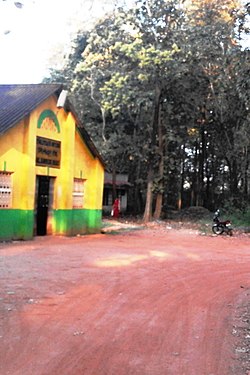Nilambur
Nilambapuri (old name) or Nilambur
India | |
|---|---|
town | |
 Nilambur Railway Staton | |
| Country | |
| Kerala, India | Kerala |


Nilambur is a municipality and a taluk in the Malappuram district of the Indian state of Kerala. It is located close to the Nilgiris range of the Western Ghats on the banks of the Chaliyar River. It is about 40 kilometers from Malappuram city and 24 kilometers from Manjeri on the Kozhikode–Gudalur road called CNG road (Calicut-Nilambur-Gudallur road).
it is the first municipality in India to achieve primary level education for all its inhabitants
Nilambur attracts tourists because of the variety of its forests that contain bamboo, teak, rosewood, etc.
Banglavum kunnu is a place located in nilambur where the DFO, under clonial india, in 1929, built a Sight seeing bunglow. The main idea of the building was to see the approach of the tippu sultan's army via naadukaani churam. The huge bunglow is situated at the centre of the nilambur forest near the chaliyar river.
Nilambur Kovilakom
Nilambur Kovilakom is a compound of several old palaces and a few new houses occupied by members of the old royal family of Nilambur. Some of the buildings are more than 200 years old.
Gateway of Nilambur
The two kilometre beautiful forest road from Vadapuram bridge to Court road Nilambur is now popularly known as gateway of Nilambur. The road is surrounded by teak plantations on both sides and foot paths are now fully tiled to offer a nice experience to walk through. This place is now emerging as popular destination for a short brake on the way to Ooty, Mysore and Bangalore.
Important landmarks
- Amal College of Advanced Studies
- Little Flower School
- Fairy Land Cinemas
- Subramanya Temple, Nilambur
- Teak Museum, teak forest and Connolly's Plot plantation
- New Amarambalam Reserved Forest
- Manavedhan higher secondary school
- Peevees Model school
- District hospital Nilambur
- Magistrate court Nilambur
- KSRTC sub depot Nilambur
Nilambur teak forest and plantations
The Nilambur forests are also known for their tribal settlements, vast rain forests, waterfalls and the world's first Teak Museum. Just 2 kilometres (1.2 mi) from Nilambur town, there is the oldest teak plantation in the world, the Conolly's Plot. It is named after H. V. Conolly, the British Malabar district collector, who was instrumental in planting teak there. Chathu Menon, a forest officer, organised the planting of the saplings. Chathu Menon was laid to rest in the teak garden. Kannimari, the plantations' oldest teak tree, is another attraction. The plot extends across 2.31 hectares (5.71 acres) besides the Chaliyar river at the Aruvakode ferry.[1]
Teak Museum
On the Nilambur–Gudallur road, 4 kilometres (2.5 mi) away from the town, there's the Teak Museum, a sub-centre of the Kerala Forest Research Institute. The two storeyed building houses exhibits, articles and details of historic, aesthetic and scientific value, which give information on all aspects of the Teak trees, plantations, and so on.[1]
Suburbs of Nilambur
- Minervapady and Perimbalavu Road
- Chandakunnu Junction and Karimpuzha
- Valuvassery, Chungathara and Palunda Village
- Edakkara Town and Palathingal
- Machu Kuzhiyil, Palad village and Nellikuth
- Vazhikkadavu and Kettungal
- Amarambalam, Chaliyar and Chokkad
- Chungathara, Edakkara and Kalikavu
- Karulai, Vazhikkadavu, Moothadem and Pothukkal
Nilambur Railway Line
Railway Stations between Nilambur and Shornur:
- Nilambur Road
- Vaniyambalam
- Thodiyappulam
- Tuvvur
- Melattur
- Angadippuram
- Cherukara
- Kurukkalloor
- Vallappuzha
- Vadanakkurishi
- Shornur
Image gallery
-
Nilambur Town
-
Nilambur Kovilakom
-
Main Temple in Kovilakom
-
Kovilakom gate
-
Nilambur Kovilakom
-
Temple in T.K.Colony
-
Rock Painting on Nadukani Road
-
Karimpuzha near Nilambur
-
Nilambur Kovilakom
-
Karimpuzha River Gauge Station
-
Vaniyambalam Railway Station
-
A Tribal School in Nilambur
References
- ^ a b "Nilambur Teak Plantation in Malappuram". keralatourism.org. Retrieved 6 January 2016.











